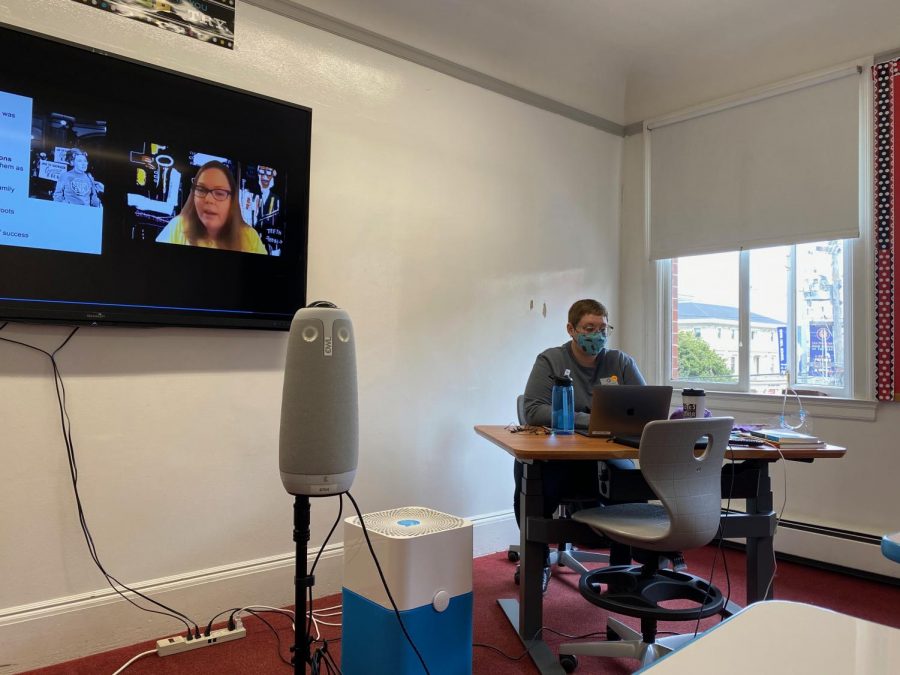Hybrid learning prompts teachers, students to employ new learning strategies
Students and teachers cope with adjusted learning situation
Gender, Power and Ethics teacher Elaina LeGault teaches in person students and remote students using the Meeting Owl. The Owl and IPads are some of the technologies Convent & Stuart Hall is providing teachers to make hybrid learning easier.
December 16, 2020
WEB EXCLUSIVE Now that Convent & Stuart Hall offers classes for students who are both on and off campus, teachers and students are facing new challenges with hybrid learning.
Not all students are learning on campus, with only approximately 126 students learning in person as of Dec. 16, according to Administrative Assistant Jeanne Asdourian. Teaching hands-on subjects such as language, biology, chemistry and art when students are not all in one classroom can be especially difficult.
“It’s been a challenge for sure and we all are trying our best to interact with each other,” Spanish teacher Diana Bolanos said. “It’s not the same as last year where we had everybody at home or everybody on Zoom,” referring to the initial shelter-in-place order for the coronavirus last March.
Masks and distance between students can interfere with language classes since students and teachers cannot see each others’ mouths moving, which is a key element of learning a new language, according to Bolanos. The hybrid learning environment can make hearing one another difficult and can discourage students from participating or asking questions.
“It’s good for the students who are here but some students struggle at home,” Bolanos said. “It’s hard to observe if they are really interacting or not.”
Science classes such as biology typically involve wet labs and experiments involving chemicals, special tools and detailed instructions, causing some teachers to employ online resources such as lab simulations where students perform an experiment using a website and observe the reactions.
“We can’t do the variety of labs right now that we could if everyone were here, because I have to make everything possible to do at home,” biology teacher Patrick Lindsay said. “Having remote learning has made me very resourceful, so I’ve discovered a lot of websites with cool activities.”
Convent & Stuart Hall has given teachers additional hardware to enhance their teaching, including iPads, document cameras and a Meeting Owl, a 360-degree camera that can capture everyone in the classroom and zooms in on an individual who is speaking or moving.
“The technology that the school has provided is quite amazing, and it worked very seamlessly,” Lindsay said. “I’ve been able to do pretty much what I want, and they provided me with an iPad which is how I grade quizzes and tests.”
For some remote students, internet complications such as the audio cutting out while learning over Zoom can be somewhat outcasting, according to freshman Jalysa Jones, who sometimes finds it difficult to connect with teachers for questions and hear in-person students speak.
“It feels really lonely and isolated on Zoom and sometimes the class will just cut out for me,” Jones said. “I’m usually a competent person and I don’t mind being alone, but I feel disadvantaged.”
Teachers are trying their best to provide the same resources to students at home and in-person, according to Visual Arts department Chair Rachel McIntire, who provides remote students with take-home supplies such as paper, pencils, water colors and Exacto knives. Teachers are utilizing school supplies and technology to make hybrid learning easier.
“We’re adapting. I think we are on a learning path to get better,” Bolanos said. “I hear some people are working with iPads, so I think I will try that at some point.”










